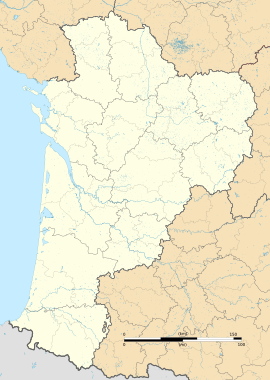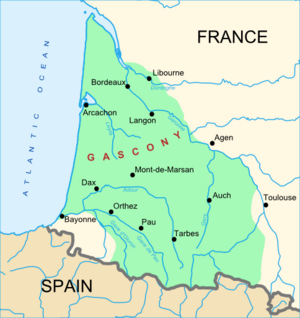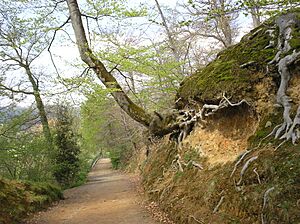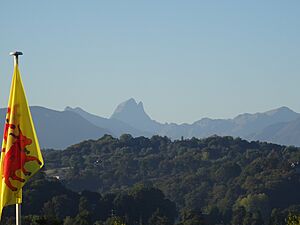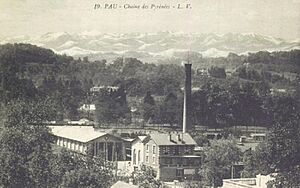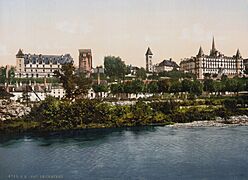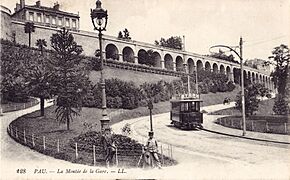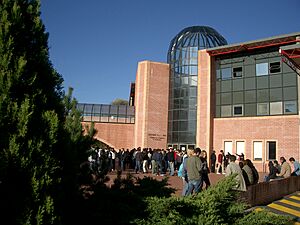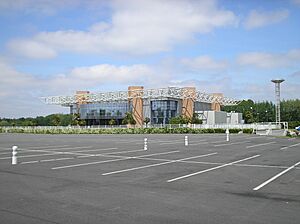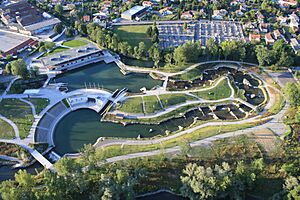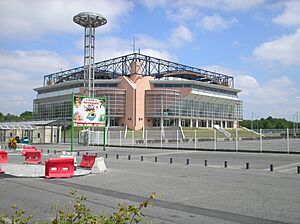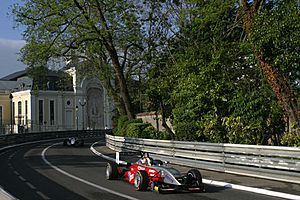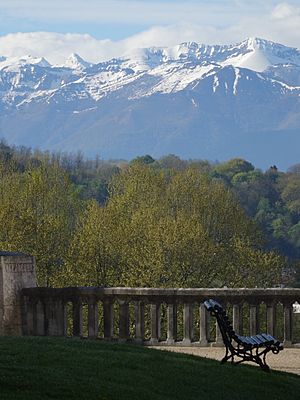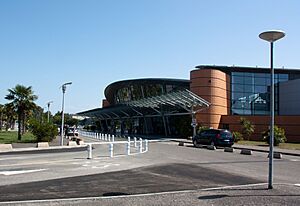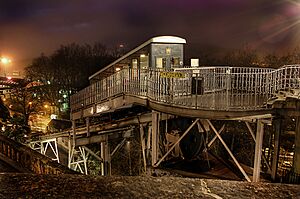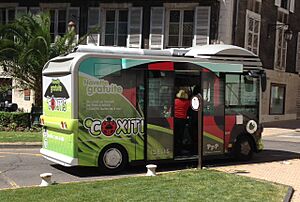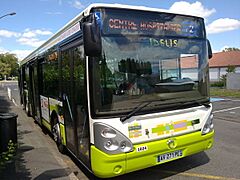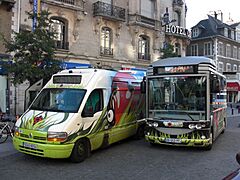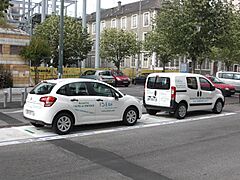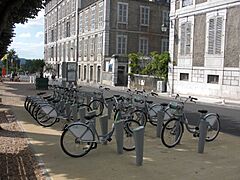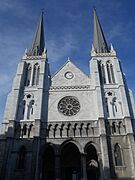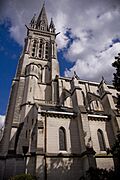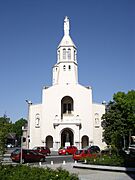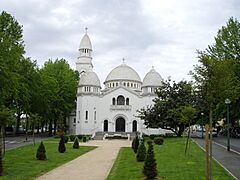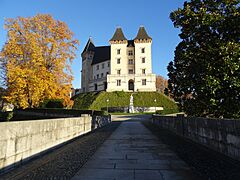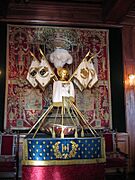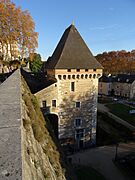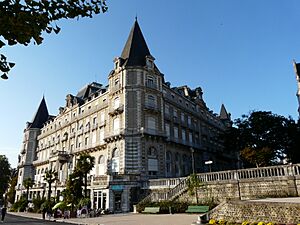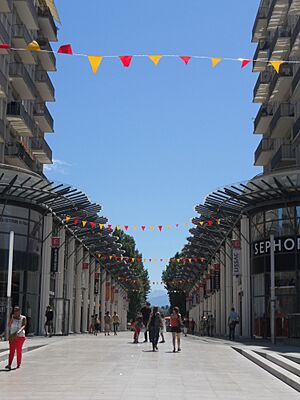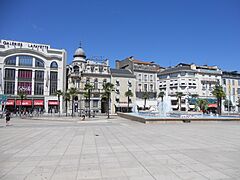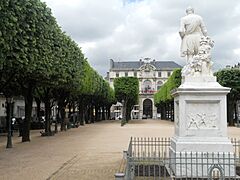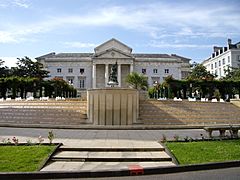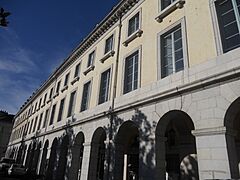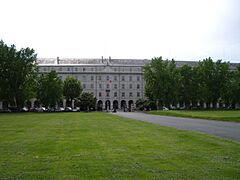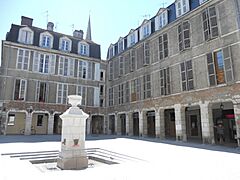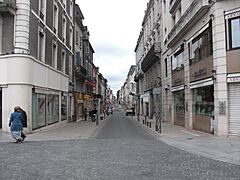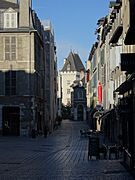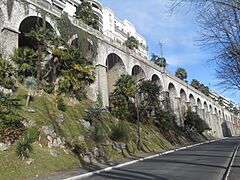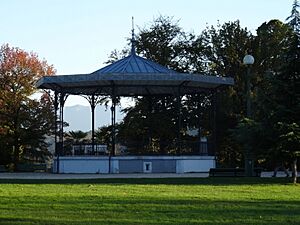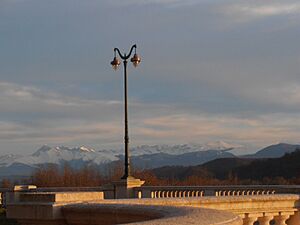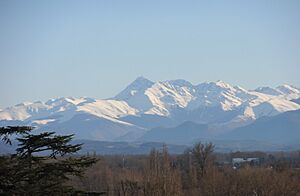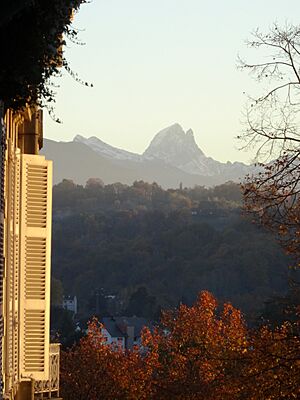Pau, Pyrénées-Atlantiques facts for kids
Quick facts for kids
Pau
|
||
|---|---|---|
|
Prefecture and commune
|
||
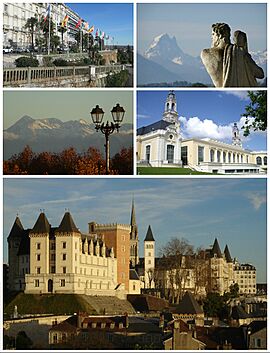
From top, left to right: the Boulevard des Pyrénées and the Pic du Midi d'Ossau; Pic du Midi de Bigorre and Palais Beaumont; Château de Pau
|
||
|
||
| Country | France | |
| Region | Nouvelle-Aquitaine | |
| Department | Pyrénées-Atlantiques | |
| Arrondissement | Pau | |
| Canton | Pau-1, 2, 3 and 4 | |
| Intercommunality | CA Pau Béarn Pyrénées | |
| Area
1
|
31.51 km2 (12.17 sq mi) | |
| Population
(2021)
|
77,066 | |
| • Density | 2,445.8/km2 (6,334.5/sq mi) | |
| Demonym(s) | Palois, paloise (French) Paulin, paulina Paulès, paulèsa (Béarnese) |
|
| Time zone | UTC+01:00 (CET) | |
| • Summer (DST) | UTC+02:00 (CEST) | |
| INSEE/Postal code |
64445 /64000
|
|
| Elevation | 165–245 m (541–804 ft) (avg. 178 m or 584 ft) |
|
| 1 French Land Register data, which excludes lakes, ponds, glaciers > 1 km2 (0.386 sq mi or 247 acres) and river estuaries. | ||
Pau is a city in France that sits high above the Pyrenees mountains. It is the main city, or prefecture, of the department called Pyrénées-Atlantiques. Pau is part of the Nouvelle-Aquitaine region.
The city is in the heart of a historic area called Béarn. Pau was its capital starting in 1464. The city is built along the Gave de Pau river. It is about 100 kilometers (62 miles) from the Atlantic Ocean and 50 kilometers (31 miles) from Spain. This location gives Pau amazing views of the Pyrenees mountains. You can see these views especially well from the famous "Boulevard des Pyrénées."
People have lived in this area since at least the Gallo-Roman times. Pau started to grow around the 12th century when its castle was built. The castle protected a river crossing, which was important for getting to the Béarn valleys and Spain. The city's name, Pau, comes from the word for a wooden fence or stockade (pau in the local Béarnese language) that surrounded the first castle.
Pau became very important in the 1500s. It was the home of the Kings of Navarre. Later, in the 19th century, Pau became a popular winter vacation spot for rich visitors. It also became a major center for early aviation, thanks to the Wright brothers.
In the 20th century, Pau's economy changed. It moved from tourism to industries like aviation and petrochemicals, especially after natural gas was found nearby in 1951. The University of Pau was founded in 1972. Today, Pau is a lively city with a rich history and a large student population. It was named a "City of Art and History" in 2011.
The people from Pau are called Palois in French. The city's motto is in Latin: Urbis palladium et gentis, which means "protective of the city and its people."
Contents
- Exploring Pau's Location
- Pau's Past: A Brief History
- People and Life in Pau
- Learning in Pau
- Delicious Food in Pau
- Culture and Fun in Pau
- Sports in Pau
- Pau's Economy and Jobs
- Getting Around Pau
- Pau's Beautiful Buildings and Places
- Awards and Recognitions
- Famous People from Pau
- Images for kids
- See also
Exploring Pau's Location
Where is Pau?
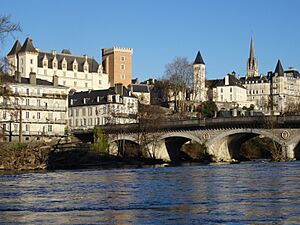
Pau is about 100 kilometers (62 miles) from the Atlantic Ocean. It is also about 50 kilometers (31 miles) from the border with Spain in the Pyrenees. This closeness to mountain passes, like the Col du Somport, made Pau a very important place for travel.
Pau is about 200 kilometers (124 miles) west of Toulouse. It is 30 kilometers (19 miles) from Tarbes and Lourdes. The large cities of Bayonne, Anglet, and Biarritz are about 110 kilometers (68 miles) away. Bordeaux is about 190 kilometers (118 miles) from Pau.
Neighboring Towns
Pau shares its borders with several other towns:
- To the north: Buros, Montardon, and Morlaàs
- To the east: Bizanos and Idron
- To the south: Gelos and Jurançon
- To the west: Lons and Billère
 |
 |
|||
Rivers and Waterways
Pau is about 200 meters (656 feet) above sea level. The city is crossed by the Gave de Pau river. A "Gave" is what people in the Pyrenees call a fast-flowing mountain river. The Gave de Pau starts in the Cirque de Gavarnie. It flows for 175 kilometers (109 miles) before joining the Adour river. This river crossing was once used by shepherds moving their sheep to high mountain pastures.
Other rivers and streams also flow through Pau. These include the Luy de Béarn, the Aïgue Longue, the Uzan, and the Ousse.
Pau's Climate
Pau has mild, wet winters and warm, drier summers. Its location near the Pyrenees gives it a special "oceanic climate." It rarely gets colder than -10°C (14°F). Snow falls about three days a year, usually between November and March.
In summer, temperatures are usually between 20°C and 30°C (68°F and 86°F). Temperatures above 35°C (95°F) are very rare. Sometimes in winter, a warm wind called the foehn can make temperatures rise above 20°C (68°F). But as soon as the wind stops, it can snow!
Pau gets a lot of rain, about 1100 mm (43 inches) per year. This is more than Paris or Bordeaux. The city gets about 1850 hours of sunshine each year. Fog is not common and usually clears up by noon. Pau is also known for not having much wind.
This mild and wet climate made Pau a popular winter resort in the late 1800s. Wealthy visitors came to enjoy the weather. It also helps the city's gardens and parks grow many beautiful and even exotic plants.
| Town | Sunshine (hours/yr) |
Rain (mm/yr) |
Snow (days/yr) |
Storm (days/yr) |
Fog (days/yr) |
|---|---|---|---|---|---|
| National average | 1,973 | 770 | 14 | 22 | 40 |
| Pau | 1,880 | 1,068.8 | 5.1 | 26.1 | 34.5 |
| Paris | 1,661 | 637 | 12 | 18 | 10 |
| Nice | 2,724 | 767 | 1 | 29 | 1 |
| Strasbourg | 1,693 | 665 | 29 | 29 | 56 |
| Brest | 1,605 | 1,211 | 7 | 12 | 75 |
| Climate data for Pau, Pyrénées-Atlantiques (1991–2020 averages, extremes 1921–present) | |||||||||||||
|---|---|---|---|---|---|---|---|---|---|---|---|---|---|
| Month | Jan | Feb | Mar | Apr | May | Jun | Jul | Aug | Sep | Oct | Nov | Dec | Year |
| Record high °C (°F) | 24.5 (76.1) |
27.8 (82.0) |
31.0 (87.8) |
30.8 (87.4) |
34.1 (93.4) |
38.1 (100.6) |
39.2 (102.6) |
39.9 (103.8) |
38.9 (102.0) |
34.0 (93.2) |
27.1 (80.8) |
27.2 (81.0) |
39.9 (103.8) |
| Mean daily maximum °C (°F) | 11.2 (52.2) |
12.3 (54.1) |
15.5 (59.9) |
17.5 (63.5) |
21.0 (69.8) |
24.1 (75.4) |
25.9 (78.6) |
26.5 (79.7) |
23.9 (75.0) |
20.1 (68.2) |
14.5 (58.1) |
12.0 (53.6) |
18.7 (65.7) |
| Daily mean °C (°F) | 6.8 (44.2) |
7.4 (45.3) |
10.3 (50.5) |
12.5 (54.5) |
16.0 (60.8) |
19.1 (66.4) |
20.9 (69.6) |
21.1 (70.0) |
18.3 (64.9) |
15.0 (59.0) |
10.0 (50.0) |
7.5 (45.5) |
13.7 (56.7) |
| Mean daily minimum °C (°F) | 2.4 (36.3) |
2.5 (36.5) |
5.0 (41.0) |
7.4 (45.3) |
11.0 (51.8) |
14.1 (57.4) |
15.8 (60.4) |
15.7 (60.3) |
12.8 (55.0) |
9.8 (49.6) |
5.5 (41.9) |
3.0 (37.4) |
8.8 (47.8) |
| Record low °C (°F) | −14.8 (5.4) |
−15.0 (5.0) |
−8.9 (16.0) |
−6.0 (21.2) |
−1.3 (29.7) |
3.6 (38.5) |
5.3 (41.5) |
5.4 (41.7) |
−1.0 (30.2) |
−4.2 (24.4) |
−9.6 (14.7) |
−12.6 (9.3) |
−15.0 (5.0) |
| Average precipitation mm (inches) | 101.8 (4.01) |
82.8 (3.26) |
85.7 (3.37) |
106.4 (4.19) |
104.2 (4.10) |
85.7 (3.37) |
64.1 (2.52) |
64.7 (2.55) |
76.8 (3.02) |
91.5 (3.60) |
132.0 (5.20) |
98.1 (3.86) |
1,093.8 (43.06) |
| Average precipitation days (≥ 1.0 mm) | 11.8 | 10.4 | 10.5 | 12.7 | 12.2 | 9.8 | 8.5 | 8.0 | 9.0 | 10.6 | 12.1 | 11.1 | 126.8 |
| Average relative humidity (%) | 83 | 80 | 77 | 78 | 78 | 78 | 78 | 80 | 80 | 83 | 83 | 84 | 80.2 |
| Mean monthly sunshine hours | 100.6 | 121.6 | 163.7 | 167.0 | 186.4 | 196.2 | 213.2 | 210.9 | 193.0 | 150.3 | 107.4 | 99.4 | 1,909.7 |
| Source 1: Météo France | |||||||||||||
| Source 2: Infoclimat.fr (humidity, 1961–1990) | |||||||||||||
Pau's Past: A Brief History
What's in a Name?
The name "Pau" has a few possible origins. One idea is that it comes from the word pal, meaning a wooden fence or palisade. This fence would have been around the first castle. Another idea is that it refers to a river crossing managed by the church, linked to the word "pious."
More recent research suggests the name comes from an old word for a rock face, *pal or *bal. This would refer to Pau's location at the foot of the mountains. The people of Pau are called paulins in Occitan and palois in French.
How Pau Began
Before the 10th century, there's no clear sign of a town where Pau is now. The city grew in a special spot. The Gave de Pau river was hard to cross. For about 50 kilometers (31 miles), there were only three places to cross. Pau was perfectly located between two of them.
A plateau overlooks this river crossing by almost 80 meters (262 feet). This made it a great place to watch over the area and control who passed through. Around the year 1000, a small fort with a simple wooden fence was built here.
In the 11th century, this fort was made stronger. A small village grew around it. The lords of Béarn gave this new village special administrative rights. The wooden fence, called Paü in the local language, is thought to be where the city's name came from.
By the 13th century, Pau had grown even more. It became a town with a local official appointed by the viscounts of Béarn.
Key Moments in Pau's History
From Castle to Capital
The powerful Gaston Fébus was a leader who wanted Béarn to be independent. He strengthened many castles, including the Château de Pau, where he eventually lived.
In 1464, Pau became the capital of Béarn, taking over from Orthez. In the early 1500s, the Château de Pau became the home of the Kings of Navarre.
Royal Births and Changes
Pau is special because two future kings who started royal families were born here. Henry IV of France, who founded the House of Bourbon, was born in 1553. Charles XIV John of Sweden of the House of Bernadotte was born in 1763.
In 1620, Béarn became part of France. Pau lost some of its power but remained important. During the French Revolution, Pau's local government was changed.
A Golden Age of Tourism
The late 1800s, known as the Belle Époque, brought new life to Pau. Many rich foreign tourists came to spend the winter because of Pau's pleasant climate. A British doctor, Alexander Taylor, even said Pau's climate had healing powers.
During this time, Pau became a world leader in the new aviation industry. This was thanks to the Wright brothers, who set up a flight school nearby in 1909.
Modern Pau: Gas and Growth
Tourism slowed down in the 20th century. Pau's economy then shifted to aviation and petrochemicals. This change was boosted by the discovery of the Lacq gas field in 1951. The University of Pau was founded in 1972, bringing many students to the city.
Pau has continued to grow and modernize. New sports facilities, a media library, and improved public transport have been built. The city is a key center for the Béarn region and beyond.
- Pau in the early 20th century
People and Life in Pau
Population Facts
Pau has about 75,665 people living in the city itself (as of 2020). The larger urban area of Pau has over 200,000 residents. This makes Pau the most populated city in the Pyrénées-Atlantiques department. It is also the fourth largest city in the Nouvelle-Aquitaine region.
The nearby towns of Billère, Lons, and Lescar are the biggest towns in the Pau area after Pau itself. Together, they add about 35,000 more people to the region.
How Pau's Population Grew
| Historical population | |||||||||||||||||||||||||||||||||||||||||||||||||||||||||||||||||||||||||||||||||||||||||||||||||||||||||||||||||||||||
|---|---|---|---|---|---|---|---|---|---|---|---|---|---|---|---|---|---|---|---|---|---|---|---|---|---|---|---|---|---|---|---|---|---|---|---|---|---|---|---|---|---|---|---|---|---|---|---|---|---|---|---|---|---|---|---|---|---|---|---|---|---|---|---|---|---|---|---|---|---|---|---|---|---|---|---|---|---|---|---|---|---|---|---|---|---|---|---|---|---|---|---|---|---|---|---|---|---|---|---|---|---|---|---|---|---|---|---|---|---|---|---|---|---|---|---|---|---|---|---|
|
|
|
|||||||||||||||||||||||||||||||||||||||||||||||||||||||||||||||||||||||||||||||||||||||||||||||||||||||||||||||||||||
| From 1962 to 1999: Population without double counting; for the years following: municipal population. Source: Ldh/EHESS/Cassini until 1999 and INSEE |
|||||||||||||||||||||||||||||||||||||||||||||||||||||||||||||||||||||||||||||||||||||||||||||||||||||||||||||||||||||||
Learning in Pau
Schools for All Ages
Pau has many schools, from kindergarten to high school.
Primary Schools
- Public Schools
|
|
|
- Private Schools
- Sainte-Ursule School
- Joyeux Béarn School
- Saint-Maur School
- Saint-François d'Assise School
- Saint-Dominique School
- Immaculée-Conception – Beau-Frêne School
- Escòla Calandreta (Bilingual French-Occitan)
- International School of Béarn (in Morlaas)
- Montessori School of Pau (French-English bilingual)
Secondary Schools
- Public Colleges (Middle Schools)
- Clermont College
- Jeanne d'Albret College
- Marguerite de Navarre College
- Private Colleges (Middle Schools)
- Immaculée Conception – Beau Frêne College
- Saint-Dominique College
- Collègi Calandreta de Gasconha
- Sainte-Ursule College
- Saint-Maur College
- Public High Schools
- Lycée Honoré-Baradat (Vocational)
- Lycée Louis-Barthou (General)
- Lycée Saint Cricq (General and Vocational)
- Lycée Saint-John-Perse (General)
- Private High Schools
- Lycée Immaculée Conception – Beau Frêne (General and Vocational)
- Lycée Saint-Dominique
Higher Education and Research
University Life
Pau has a long history of higher education, with a university founded in 1722. Today, it's the second-largest student city in Aquitaine. Pau has about 17,000 students and 3,900 researchers. The University of Pau and Pays de l'Adour (UPPA) offers many subjects like law, economics, and sciences.
The university also has several engineering schools, business schools, and art schools. The Pyrénées Oceanes Research Campus brings together many of these schools. It also connects with universities in Spain, making it a European hub for learning.
Specialized Schools and Research
Pau is home to many specialized schools. These include the ENSGTI for engineering, CY Tech for computer science, and the Groupe ESC Pau for business. There's also a National School of Music and Dance and the famous School of Airborne Troops, which trains French paratroopers.
Pau is also a center for research. The university has many research teams, some working with national science organizations. There are also research centers focused on petroleum engineering, environmental biology, and new materials. The Jean-Feger Scientific and Technical Centre of TotalEnergies is a major oil research center in Europe.
Delicious Food in Pau
Pau is the historic capital of Béarn, so it offers many tasty local dishes. Here are some of them:
- Garbure: A hearty soup made with cabbage, beans, and duck or ham.
- Confit: Dishes made from duck or goose, like duck breast (Magret).
- Ventrèche: Slices of dried pork belly, often eaten with a fried egg.
- Broye: Thick, salty boiled corn flour, fried or eaten with coffee and milk.
- Trinxat: A mountain dish of mashed cabbage and potatoes mixed with smoked bacon.
- Palombe: Local name for wood pigeon, cooked in sauce or roasted.
- Poule au pot: A stuffed chicken boiled in a stew.
- Bayonne Ham: A famous ham from the Béarn region, historically exported from Bayonne.
- Pyrenean Cheese: Sheep's milk cheese from the mountains, like Ossau-Iraty. It's delicious with black cherry jam.
- Coucougnettes du Vert Galant: A sweet candy with a hazelnut, chocolate, and almond paste. It was named the best sweet in France in 2000!
- Gâteau à la broche: A tall, pyramid-shaped cake, often made for weddings.
- Merveilles: Crispy fried pastries, traditionally made for Mardi Gras.
- Honey: From the hillsides of Jurançon and Saint-Faust.
- Jurançon: A famous dry or sweet white wine.
- Madiran wine: A red wine.
- Béarn wine: A light red wine.
- Pacherenc wine: A sweet white wine.
Culture and Fun in Pau
Language and Identity
Pau has a strong cultural identity. Many people speak or learn Béarnese, a dialect of the Occitan language. There are even bilingual schools where children learn in both French and Occitan. Pau also has been influenced by English, Spanish, Russian, and Brazilian cultures.
The city hosts the Hestiv'oc festival every year. It is a big celebration of Occitan music and culture.
Cultural Places to Visit
- The Zénith: A modern venue that can hold up to 6,800 people. It hosts concerts, shows, and other events with national and international artists.
- André Labarrère Intercommunal Library: A large, modern library that opened in 2012. It has over 184,000 documents, including books, CDs, and DVDs. It also has an auditorium and exhibition hall.
- The Palais Beaumont: This building is an auditorium and a congress center. It hosts the Symphony Orchestra of Pau-Pays de Béarn.
- The Parc des expositions de Pau: This exhibition center hosts about 200 events and 450,000 visitors each year.
- Cinemas: Pau has several cinemas, including the Méga CGR with 12 screens and the CGR Saint-Louis. The Le Méliès Cinema shows art films and hosts the International Festival of Film of Pau.
- Les Abattoirs: An old slaughterhouse that was turned into a cultural center. It has a concert hall, exhibition spaces, and recording studios.
Museums to Explore
- National Museum of the Château de Pau: Located in the castle where Henry IV was born. It's a medieval fortress, a Renaissance palace, and a royal home. It's one of France's most visited national museums.
- Musée des beaux-arts de Pau: This art museum opened in 1864. It has paintings from the 15th to the 20th century by famous artists like Degas, El Greco, and Rubens.
- Musée Bernadotte: This museum is in the house where Jean-Baptiste Jules Bernadotte was born. He became a Marshal of France and then King of Sweden. The museum shows what life was like in Pau in the 18th century.
- Museum of Paratroopers: This museum tells the story of paratroopers in Pau.
Festivals and Events
Pau hosts many festivals throughout the year:
- Carnival Biarnés: A lively carnival celebration.
- Festival Hestiv'Oc: A big festival of music and culture from southern France.
- L'Été à Pau (Summer in Pau): A summer festival.
- International Festival of Film of Pau: A film festival that started in 2010.
Sports in Pau
Pau is a city that loves sports! It has many sports facilities and successful teams.
Sports Clubs
- Basketball: The professional club Élan Béarnais Pau-Orthez has won the French Championship nine times. They also won the European Korać Cup in 1984.
- Rugby union: The Section Paloise club is one of France's oldest rugby clubs. They have won the French Championship three times and the European Challenge Cup once.
- Canoe-kayak: The CUPPEV club has produced several Olympic and world champions, including Tony Estanguet, who won three Olympic gold medals.
- Fencing: The Section paloise (fencing) is one of France's top fencing clubs. They have won many national and international titles.
- Football: Pau Football Club has played in France's national leagues. Many players who later became professionals played for Pau FC.
Sports Facilities
- The Stade du Hameau: A stadium with 13,966 seats, home to the Section Paloise rugby team and Pau FC football team.
- The Palais des Sports de Pau: With 7,856 seats, it's the second-largest indoor arena in France. It hosts basketball games and other major sports events.
- The Circuit de Pau-Ville: A temporary motor racing circuit in the city streets. It hosts the famous Pau Grand Prix.
- Whitewater Stadium: Opened in 2008, this man-made basin is fed by the Gave de Pau. It's used for canoe-kayak training and competitions, including World Cups.
- Pont-Long Racecourse: The second-largest equestrian center in France for steeplechase horse racing.
- Basque Pelota Complex: Opened in 2006, this is the largest Basque pelota facility in Europe.
- Golf Courses: Pau has two golf courses, including the Pau Golf Club in Billère. It was built in 1856 and is one of the oldest in Europe.
Major Sporting Events
Pau is a regular stop for the Tour de France cycling race. It has hosted stages 63 times! Only Paris has hosted more stages.
The Étoiles de Pau ("Stars of Pau") is a very important eventing competition in October. It's one of only six in the world with the highest rating.
The Pau Grand Prix
Pau held the very first race ever called a "Grand Prix" in 1901. The race track, 2.769 kilometers (1.72 miles) long, winds through the city streets. It has stayed mostly the same over the years.
The Pau Grand Prix used to open the racing season. It has hosted different types of races, from Formula One to Formula Three and now the World Touring Car Championship. There's also a Grand Prix de Pau Historique where old racing cars compete.
Pau's Economy and Jobs
From the 1950s to the 1990s, Pau's economy relied on natural gas and sulfur production from the nearby Lacq gas field. Today, the main industries in the Béarn area are oil, aerospace, tourism, and agriculture. Pau is where Elf Aquitaine started, which is now part of TotalEnergies.
Pau is the second-largest economic center in Aquitaine, after Bordeaux. It has many important industrial and research centers. These focus on petroleum engineering, petrochemistry, food, automotive, aeronautics, and computer science.
Key Industries
The discovery of the Lacq gas field in the 1950s brought a big boost to Pau's economy. It was one of Europe's largest gas fields. Many oil and chemical companies, like TotalEnergies and Arkema, are located in or near Pau.
Pau is also part of the Aerospace Valley, a major aerospace hub with Toulouse and Bordeaux. Companies like Safran and Turbomeca (which makes helicopter engines) have a strong presence here. These companies work on parts for Airbus and Boeing planes.
The pharmaceutical industry is also growing in Pau, with companies like Pierre Fabre and Sanofi. The agri-food industry is important too, especially for corn, dairy products, and wine.
Services and Technology
Pau is a regional center for many service companies. These include banking, insurance, and construction firms.
The city has also seen a lot of growth in ICT businesses. Pau was one of the first cities in Europe to develop a very high-speed fiber-optic network. This has attracted many tech companies.
Pau is also a popular place for business meetings and conferences. The Palais Beaumont Congress Centre and various hotels help host these events.
The city is home to several army units, including the 5th regiment of combat helicopters. This means the defense sector provides over 2,000 jobs in Pau.
Tourism in Pau
Pau is a great place for tourists. It's only 45 minutes from the Pyrenees mountains and its ski resorts. It's also close to the Basque and Landes coasts, where you can enjoy water sports.
Pau is a gateway to the five Béarnese valleys. These valleys offer winter sports, spas, and green tourism like hiking and cultural visits.
The city's location at the foot of the Pyrenees gives it amazing views. The Boulevard des Pyrénées is a long avenue where you can see the entire mountain range. There are even special markers to help you identify the different peaks.
Pau is the most beautiful view of Earth from the world as Naples is the most beautiful view of sea.
Pau is also a city rich in history and culture. It's a former royal town and a popular place for business conferences. The city also has a casino.
Pau has a special connection to the United Kingdom. Many British tourists visited in the past and left their mark. The first 18-hole golf course in Europe was created near Pau in 1856 by Scots.
Getting Around Pau
Train Travel

The Gare de Pau railway station connects Pau to major cities like Bordeaux, Bayonne, Toulouse, and Paris.
- The TGV high-speed train links Pau to Paris in about 5 hours.
- Other trains connect Pau to Bordeaux, Tarbes, and Hendaye (Spain).
- There are also night trains to Paris and Geneva (Switzerland).
Plans are being considered to extend the high-speed train line from Bordeaux to Spain. This would make Pau even closer to Paris. There are also talks about reopening a train line connecting Pau to Canfranc in Spain.
Flying from Pau
The Pau-Pyrénées International Airport is about 12 kilometers (7.5 miles) northwest of the city. It has direct flights to Paris, Marseille, Lyon, London, Southampton, and Amsterdam. In 2009, it served 690,000 passengers.
Driving to Pau
- The A64 motorway, also called la Pyrénéenne, connects Pau to Toulouse in about 2 hours and to Bayonne in about 1 hour and 17 minutes.
- The A65 motorway, called A'Liénor, connects Pau to Bordeaux in about 2 hours and 21 minutes. This is known as the most expensive motorway in France.
Funicular and Buses
The Funiculaire de Pau is a funicular railway that opened in 1908. It connects the city center and the Boulevard des Pyrénées to the railway station down in the valley. It's free to use and carries about 500,000 passengers each year. It runs every day.
Pau also has a bus network called IDELIS. It operates 13 bus routes serving Pau and nearby towns. There's even a free shuttle bus service called Coxitis that goes around the city center.
Pau's Beautiful Buildings and Places
Pau has many historic buildings and sites, from its ancient castle to modern structures.
Churches and Chapels
Main Catholic Churches
- Church of Saint-Martin: Located in the old town, this church was built in the 1860s in a neo-Gothic style. Its automatic carillon plays Mozart tunes every Sunday.
- Church of Saint-Jacques: Also in a Gothic style, this church was finished in 1867. Its two spires were put back in 2012 after being removed due to storm damage.
- Notre-Dame Church: Built in the early 20th century, this church has a large statue of the Virgin and child on top.
- Church of Saint-Joseph: Built in 1935, this church has a neo-Byzantine style with domes and a 50-meter (164-foot) tall bell tower.
- St Peter's Church: Built in 1970, this modern church is covered with slates and blends with the surrounding concrete buildings.
Other Notable Chapels
- The former Convent of the Réparatrices: This impressive chapel now houses the National School of Music and Dance.
- The Chapel of Saint-Louis-de-Gonzague: This classic chapel is part of the former Jesuit college, now Lycée Louis-Barthou.
- The Chapel of Notre-Dame-du-bout-du-Pont: This chapel was built in 1872, then carefully taken apart stone by stone and rebuilt in a new location in 1932.
Other Religious Buildings
Pau also has a Russian Orthodox Church, a mosque, a synagogue, and other smaller churches.
Important Civil Buildings
Historic Landmarks
The Château de Pau stands proudly over the Gave de Pau river. Its oldest towers are from the 12th century. It was a fortress, then a Renaissance palace, and the birthplace of King Henry IV. The Tour de la Monnaie (Money Tower) was once used to make coins.
Near the castle is the Parlement de Navarre. This old courthouse was built in 1585. Today, the General Council still holds its meetings here.
Lycée Louis-Barthou was originally a Jesuit college built in the 1600s. Many famous people studied here, including Lautréamont and Pierre Bourdieu.
The Bernadotte Museum is the birthplace of Jean-Baptiste Jules Bernadotte. He was a French soldier who became King of Sweden.
19th Century Buildings
The Hotel de Gassion and Hotel de France were once grand hotels from the Belle Époque. They are located on the Boulevard des Pyrénées. The Hotel de Gassion is now apartments, and the Hotel de France houses city offices.
The Palais Beaumont, once called the Palais d'Hiver (Winter Palace), was built in the late 1800s. It has a mix of architectural styles. After being neglected, it was renovated in 1996 and is now a convention center and casino.
The Funiculaire de Pau opened in 1908. It's a funicular that connects the city center to the railway station below.
Pau's town hall is in a building that was originally a theater from 1862. You can see a statue of Thalia, the muse of comedy, on its front.
The 19th century also saw many beautiful villas built in Pau. Rich English, American, and Russian tourists built these English-style homes. Many are still used today as hotels or residences.
The current courthouse was built starting in 1847. The railway station, with its Eiffel-style design, opened in 1871.
The Bernadotte Barracks were built between 1825 and 1875. They now hold the national archives of the army. The large Place de Verdun was once a military exercise area.
Modern Buildings (20th and 21st Century)
- Hôtel du Département: Opened in 2000, this glass building houses administrative services.
- Bosquet Centre: A modern shopping center in the city center, renovated in 2007.
- Palais des Pyrénées: Another shopping center in the city center. It has a history of being a market, then a complex with shops and theaters, and now a modern shopping area with glass and steel canopies.
- Departmental Archives: Since 1971, the archives have been in buildings with unique triangular windows designed to protect documents.
- Community Archives: Since 2011, these archives are in the former tram factory building.
Special Areas and Streets
Town Squares
- Place Clémenceau: The main square in downtown Pau. It's a popular spot for festivals and shopping.
- Place d'Espagne: A square with modern buildings and the Bosquet shopping center.
- Place des États: An old crossroads near the castle.
- Place Gramont: An 18th-century square with many outdoor cafes.
- Place Reine-Marguerite: Once a marketplace, bordered by arcades.
- Place Royale: Created by Louis XIV, it has a statue of Henry IV and the Pau Town Hall.
- Place de Verdun: A large square used for parking, next to the Bernadotte military barracks.
- Place de la Libération: This square has the Palace of Justice and the Santiago Church.
Famous Streets
- The Boulevard des Pyrénées: This 1.8-kilometer (1.1-mile) long avenue offers an amazing panoramic view of the Pyrenees mountains. You can see peaks like the Pic d'Anie, Pic du Midi de Bigorre, and the distinctive Pic du Midi d'Ossau. There are even special plates to help you identify the mountains.
- The Rue du Maréchal-Joffre: This street connects the Château Quarter to Place Clemenceau. It was once called Grande Rue and helped Pau grow. It's now a pedestrian street with many historic houses.
Unique Neighborhoods
- The Château Quarter: This historic area has narrow, old lanes that give it a medieval feel.
- The Hedås Quarter: An old neighborhood built in a ravine, right in the heart of the historic city.
- The Trespoey Quarter: A very green area with many 19th-century English-style villas. It's historically a more upscale part of the city.
Green Spaces and Views
Parks and Gardens
Pau is a very green city, with over 750 hectares (1,853 acres) of green areas. It has many rare and exotic plants. Pau has been recognized as a "4 flowers" city for its beautiful flowers and gardens. It has about 80 square meters (861 square feet) of greenery per person.
- Parc Beaumont: A large park with a lake, river, and waterfall. It has many flower beds, a rock garden, and a rose garden. This 12-hectare (30-acre) park has 110 types of trees.
- Parc Lawrence: A park with old trees and one of Pau's 19th-century English villas.
- National Domain of the Château de Pau: Includes a Renaissance garden with medicinal plants and a large park for outdoor activities.
- Johanto Gardens: At the bottom of the Boulevard des Pyrénées, known for its many palm trees.
- Kōfu Garden: A Japanese garden opened in 2005, designed by gardeners from Pau's sister city, Kōfu.
Protecting Pau's Views
The "Horizons Palois" (Pau Horizons) project aims to protect the amazing views from Pau. These views include the Gave de Pau river and the hills of Jurançon, leading up to the Pyrenees mountains. Seventeen sites were registered in 1944 to protect them from new buildings that might block the view. Pau is even trying to get these views recognized as a UNESCO World Heritage site.
Awards and Recognitions
- City of Art and History: Awarded in 2011.
- "4 Flowers" City: Recognized since 1983 for its beautiful flowery cities and villages.
- UNICEF Child Friendly City: Shows Pau's commitment to children's well-being.
- TOP COM Gold Award: Won in 2006 for its excellent website.
Famous People from Pau
Born in Pau



- Henry IV of France (1553–1610): King of France and Navarre.
- Jean-Baptiste Jules Bernadotte (1763–1844): A French Marshal who became King of Sweden and Norway.
- Charles-Denis Bourbaki (1816–1897): A famous general.
- André Courrèges (1923–2016): A fashion designer known for helping make the miniskirt popular.
- André Labarrère (1928–2006): A former Mayor of Pau and Minister.
- Bertrand Cantat (1964): A singer and actor.
- Frédéric Lopez (1967): A television host.
- Éric Piolle (1973): The current mayor of Grenoble.
- Fabienne Carat (1979): An actress.
- Isabelle Ithurburu (1983): A television presenter.
Sports Stars Born in Pau

- Victor Fontan (1892–1982): A cyclist who led the Tour de France in 1929.
- Marguerite Broquedis (1893–1983): A professional tennis player.
- Robert Haillet (1931–2011): A tennis player.
- Philippe Bernat-Salles (1970): A former international rugby player for France.
- Jérôme Garcès (1973): An international rugby referee.
- Tony Estanguet (1978): A triple Olympic champion in slalom canoeing (2000, 2004, 2012). He is now the President of the Paris 2024 Olympic Organizing Committee.
- Damien Traille (1979): A rugby union player.
- Jérémy Chardy (1987): A tennis player.
- Alexandra Lacrabère (1987): A handball player.
- Edwin Jackson (1989): A professional basketball player.
People Who Lived or Died in Pau
- Henry II of Navarre (1503–1555): King of Navarre, who died in Pau.
- Jean-Jacques Ampère (1800–1864): A famous scholar and writer.
- The emir Abd el-Kader (1808–1883): An Algerian leader who was imprisoned in Pau castle in 1848.
- Mary Todd Lincoln (1818–1882): The widow of American President Abraham Lincoln, who lived in Pau for several years.
- Isidore Ducasse (1846–1870): A writer who studied in Pau.
- Louis Barthou (1862–1934): A politician who lived in Pau.
- Saint-John Perse (1887–1975): A Nobel Prize-winning poet who studied in Pau.
- Pierre Bourdieu (1930–2002): A famous sociologist who studied in Pau.
- François Bayrou (1951): The current mayor of Pau.
Images for kids
See also
 In Spanish: Pau (Francia) para niños
In Spanish: Pau (Francia) para niños




